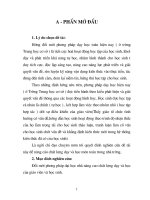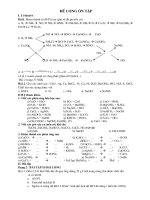Jensen’s Inequality
Bạn đang xem bản rút gọn của tài liệu. Xem và tải ngay bản đầy đủ của tài liệu tại đây (161.72 KB, 6 trang )
Chapter 7
Jensen’s Inequality
7.1 Jensen’s Inequality for Conditional Expectations
Lemma 1.23 If
' : IR!IR
is convex and
IE j'X j 1
,then
IE 'X jG 'IE X jG:
For instance, if
G = f; g;'x= x
2
:
IEX
2
IEX
2
:
Proof: Since
'
is convex we can express it as follows (See Fig. 7.1):
'x= max
h'
h
is linear
hx:
Now let
hx=ax + b
lie below
'
. Then,
IE 'X jG IE aX + bjG
= aIE X jG+b
= hIEXjG
This implies
IE 'X jG max
h'
h
is linear
hIE X jG
= 'IE X jG:
91
92
ϕ
Figure 7.1: Expressing a convex function as a max over linear functions.
Theorem 1.24 If
fY
k
g
n
k=0
is a martingale and
is convex then
f'Y
k
g
n
k=0
is a submartingale.
Proof:
IE 'Y
k+1
jF
k
'IE Y
k+1
jF
k
= 'Y
k
:
7.2 Optimal Exercise of an American Call
This follows from Jensen’s inequality.
Corollary 2.25 Given a convex function
g :0;1!IR
where
g 0 = 0
. For instance,
g x=
x,K
+
is the payoff function for an American call. Assume that
r 0
. Consider the American
derivative security with payoff
g S
k
in period
k
. The value of this security is the same as the value
of the simple European derivative security with final payoff
g S
n
, i.e.,
f
IE 1 + r
,n
g S
n
= max
f
IE 1 + r
,
g S
;
where the LHS is the European value and the RHS is the American value. In particular
= n
is an
optimal exercise time.
Proof: Because
g
is convex, for all
2 0; 1
we have (see Fig. 7.2):
g x = g x +1,:0
g x+1, :g 0
= g x:
CHAPTER 7. Jensen’s Inequality
93
( x, g(x))λλ
( x, g( x))λλ
(x,g(x))
x
Figure 7.2: Proof of Cor. 2.25
Therefore,
g
1
1+r
S
k+1
1
1+r
gS
k+1
and
f
IE
h
1 + r
,k+1
g S
k+1
jF
k
i
= 1 + r
,k
f
IE
1
1+r
gS
k+1
jF
k
1 + r
,k
f
IE
g
1
1+ r
S
k+1
jF
k
1 + r
,k
g
f
IE
1
1+ r
S
k+1
jF
k
= 1 + r
,k
g S
k
;
So
f1 + r
,k
g S
k
g
n
k=0
is a submartingale. Let
be a stopping time satisfying
0 n
.The
optional sampling theorem implies
1 + r
,
g S
f
IE 1 + r
,n
g S
n
jF
:
Taking expectations, we obtain
f
IE 1 + r
,
g S
f
IE
f
IE 1 + r
,n
g S
n
jF
=
f
IE 1 + r
,n
g S
n
:
Therefore, the value of the American derivative security is
max
f
IE 1 + r
,
g S
f
IE 1 + r
,n
g S
n
;
and this last expression is the value of the European derivative security. Of course, the LHS cannot
be strictly less than the RHS above, since stopping at time
n
is always allowed, and we conclude
that
max
f
IE 1 + r
,
g S
=
f
IE 1 + r
,n
g S
n
:
94
S = 4
0
S (H) = 8
S (T) = 2
S (HH) = 16
S (TT) = 1
S (HT) = 4
S (TH) = 4
1
1
2
2
2
2
Figure 7.3: A three period binomial model.
7.3 Stopped Martingales
Let
fY
k
g
n
k=0
be a stochastic process and let
be a stopping time. We denote by
fY
k^
g
n
k=0
the
stopped process
Y
k^ !
! ;k=0;1;::: ;n:
Example 7.1 (Stopped Process) Figure 7.3 shows our familiar 3-period binomial example.
Define
! =
1
if
!
1
= T;
2
if
!
1
= H:
Then
S
2^ !
! =
8
:
S
2
HH=16
if
! = HH;
S
2
HT =4
if
! = HT;
S
1
T =2
if
! = TH;
S
1
T=2
if
! = TT:
Theorem 3.26 A stopped martingale (or submartingale, or supermartingale) is still a martingale
(or submartingale, or supermartingale respectively).
Proof: Let
fY
k
g
n
k=0
be a martingale, and
be a stopping time. Choose some
k 2f0;1;::: ;ng
.
The set
f kg
is in
F
k
,sotheset
f k +1g= f kg
c
is also in
F
k
. We compute
IE
h
Y
k+1^
jF
k
i
= IE
h
I
f kg
Y
+ I
f k+1g
Y
k+1
jF
k
i
= I
f kg
Y
+ I
f k+1g
IE Y
k+1
jF
k
= I
f kg
Y
+ I
f k+1g
Y
k
= Y
k^
:
CHAPTER 7. Jensen’s Inequality
95









